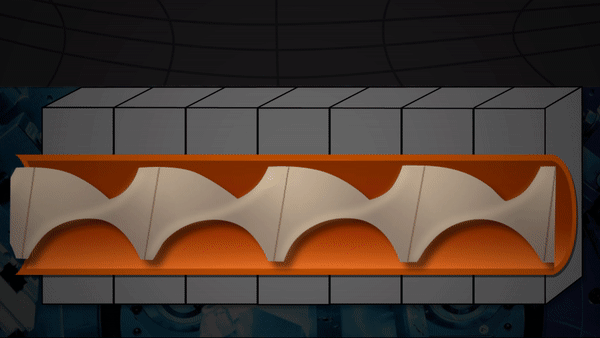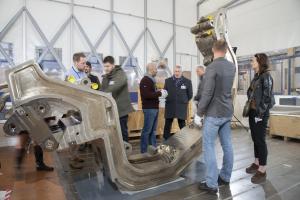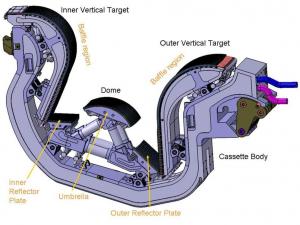Cassette body
Weighing nearly 5 tonnes, each cassette body is a stainless-steel structure designed to house the plasma-facing components of the divertor while resisting transient electromagnetic-induced loads as high as 100 tonnes.
This month, members of the ITER Divertor Section visited CEA-Cadarache (next door to the ITER site in France) where, as part of a contractual partnership between the ITER Organization and the French Alternative Energies and Atomic Energy Commission (CEA), a cassette body prototype built by the French-Italian consortium CNIM-SIMIC recently underwent final acceptance tests, including leak-tightness tests and dimensional inspections.
Such final tests will be performed by the ITER integrator on all 58 cassette bodies (including 4 spares). The European Domestic Agency, Fusion for Energy,
has awarded contracts for a first batch of 19 identical cassette bodies to Walter Tosto (Italy, 15 units) and CNIM-SIMIC (4 units, to be built in France). Contracts for the remaining 39 cassette bodies, which have an added level of complexity due to interfaces with diagnostic instruments, will be awarded later.
Plasma-facing components
With essentially the same purpose in the divertor, the plasma-facing components—the inner vertical target, the outer vertical target, and the dome—differ most in shape and location on the cassette assemblies.
Armoured by 300,000 individual monoblocks of tungsten—the element with the highest melting temperature of any metal—the targets of the divertor will receive the heaviest thermal loads inside the machine.
Evacuating this heat requires an innovative "active cooling" process, in which pressurized water is pumped through copper alloy tubes running through the monoblocks. As twisted copper rods twirl through the tubes, heat is conducted away from the plasma-facing components into the water and carried away. Water enters at a temperature of 70 °C and exits at 120 °C—and yet it is essential that it does not boil, which would reduce its ability to absorb and remove heat.
![]()
To prevent a so-called "burn out" boiling crisis, which could damage the cooling system and trigger costly delays, a series of acoustic instruments will listen for bubbles in the water lines and work in coordination with other sensors to monitor the health of the components.
Lengthy qualification activities to prepare for the manufacturing of the plasma-facing targets are nearing conclusion. At the
Divertor Test Facility in Russia, full-scale prototypes supplied by Europe (
inner vertical target) and Japan (outer vertical target) have successfully passed performance tests. The first 1-tonne dome prototype, supplied by the Russian Domestic Agency, is undergoing similar heat flux testing now.
Actively cooled plasma-facing units similar with the ones that will be used in the ITER Divertor are currently being put to the test in the
WEST tokamak of CEA Cadarache. By deliberately misaligning experimental sections of the tungsten monoblocks and exposing them to long-pulse plasmas similar to those that will exist in ITER, the WEST Joint Team is documenting the importance of perfect manufacturing.
If just one surface monoblock is misaligned, due to the shallow angle of incidence of the magnetic lines, its exposed face will receive extra-large thermal loads and could melt, having a deleterious effect on the purity of the plasma and potentially damage the next plasma-facing units.
Sensors for diagnostics and operation
Some divertor cassettes will also carry diagnostics and operational instruments to allow engineers to monitor their structural behaviour. Three of the cassette assemblies, for example, will house highly sensitive
fibre optic sensors capable of measuring temperature, strain, displacement, and vibrations inside the chamber. These sensors must be resistant to extreme amounts of radiation from both gamma rays and free neutrons at levels that have never been achieved by industry.
Special fibres, made of non-standard Fiber Bragg Grating, have been tested for radiation resistance by the National Nuclear Center of the Republic of Kazakhstan as part of a
Cooperation Agreement signed with the ITER Organization in 2017.
Installation
Once the cassette assemblies are fitted with plasma-facing components and sensors, they will be inserted through the lower port windows of the machine and locked into place on carefully aligned rails at the bottom of the chamber by specially designed robotic handling tools.





